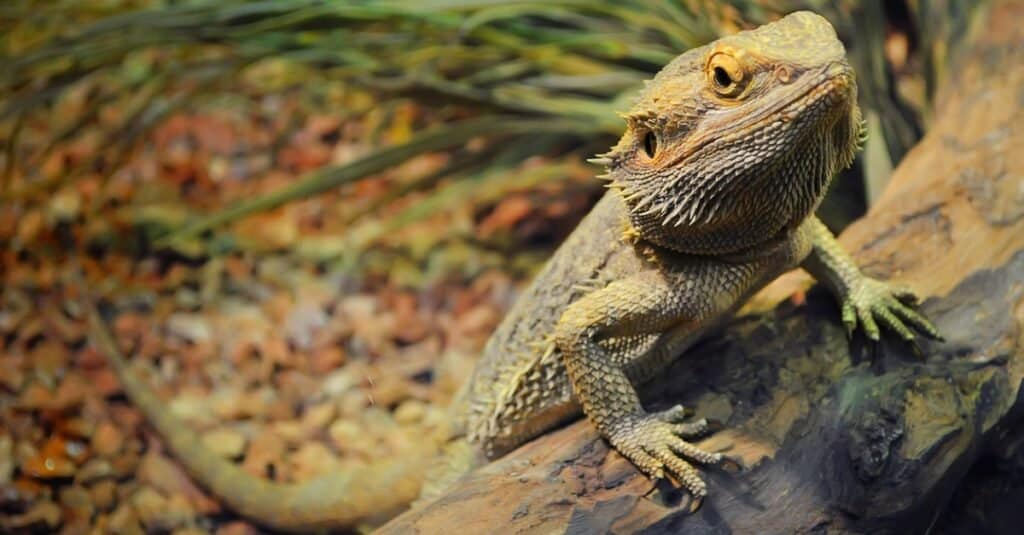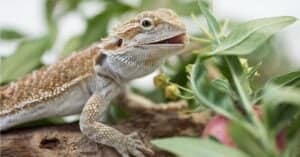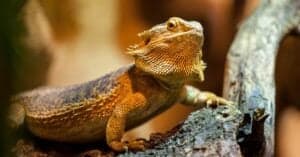
Found in the wild in Australia, the bearded dragon is also a popular choice for those interested in keeping a reptile as a pet. The bearded dragon likes a varied diet. It enjoys many different types of foods, and it is important to provide variety in the diet to ensure he gets the nutrients needed to stay strong and healthy.
Bearded dragons’ name comes from their beard of scales around their neck, however, they don’t really have a beard of fur or hair. Bearded dragons wave to each other to acknowledge another dragon. Bearded dragons love to sunbathe and have plenty of different behaviors to add to their personalities. They can run up to 9 miles an hour and enjoy walks on leashes.
Bearded Dragons Eat Fruit
Fruit is an easy way to provide nutrients to your bearded dragon. It will enjoy these offerings, but it is important to understand that some fruit is not easy for it to digest. Citrus fruit and avocados, for example, should not be offered.
What fruits can bearded dragons eat? Several commonly available choices from the grocery store, such as apples, strawberries, grapes, melons, peaches, and even raisins, are popular with bearded dragons. Chop fruit into bite-sized pieces before serving to your bearded dragon.
While fruit is healthy and bearded dragons enjoy many different types of fruit, it should not make up the bulk of their diet. Occasional offerings are enough to add variety and nutrition to their meal plan.
Bearded Dragons Eat Vegetables
Vegetable choices like bell peppers, cabbage, celery, peeled cucumber, zucchini, and carrots are good choices for your bearded dragon. Nutrient-rich greens, such as collard and mustard greens are also an excellent choice. Avoid iceberg lettuce and spinach.
Calcium binds to spinach, making it a challenge for the bearded dragon to digest, and iceberg lettuce offers little nutritional value.
As with fruits, cut vegetables into manageable-sized chunks before offering them to your pet. When offering foods such as butternut and acorn squash, cook the vegetable first to enhance digestion and make it easier for your bearded dragon to eat.
A quick boil, bake, or steam, with no added fats or seasonings, ensures the vegetable is safe and healthy for your pet. Be sure to allow the food to cool to room temperature before offering it to your beardy.
Bearded Dragons Eat Bugs
Bearded dragons enjoy eating insects, but you must get them from a reputable source. Offering your beardie insects you catch yourself can cause health problems.
The insect most people think of when it comes to bearded dragons is the cricket. While crickets are a good choice, and beardies generally enjoy them, there are other insects you can offer as well. Dubai roaches, locusts, and black soldier fly larvae are also popular choices. Bearded dragons also enjoy different types of worms, such as earthworms, super worms, redworms, and butterworms.
To make sure the insects you provide your beardie offer the nutrition he needs, gut load them before feeding him. The gut loading process involves purchasing specialized food for the insects. Feeding the insects a gut-loading diet ensures the animals provide the nutrition your pet needs.
How Bearded Dragons Hunt
Provide live insects for your bearded dragon. Hunting them down in his enclosure provides enrichment activity as well as food. He will capture the insects just as he would in the wild, by quickly unfurling his sticky tongue to grab the morsel, then pulling it into his mouth.
Once in his mouth, his powerful jaws make quick work of the prey.
Special Treats for Your Bearded Dragon

©Shinedawn/Shutterstock.com
In addition to insects, fruit, and vegetables, there are some different plants and herbs your beardie may enjoy. Fresh herbs such as sage, basil, chives, and oregano are popular. Grasses such as dandelion greens and clover are as well. Flower s such as impatiens and carnations are also a nice treat for your beardie. As with anything you feed your pet, the plants must be free from pesticides and other chemicals.
The Bearded Dragon’s Diet By Age
Like many lizards, the bearded dragon has specific nutritional needs during different life stages. Until the beardie is 18 months old, he needs a high protein diet to support the rapid growth he experiences. Plan to feed a diet of 75 percent insects. The remaining 25 percent of the diet should be a variety of plant materials.
When less than two months old, the beardie needs insects such as crickets throughout the day. Once he reaches two months of age, his feeding schedule can be reduced to three meals a day.
Once the beardie is a year and a half old, he only needs one meal a day. He also doesn’t require as much protein. The bulk of his diet, about 75 percent, should be made up of plant materials. The remaining 25 percent should be insects.
What Eats a Bearded Dragon?
Lizards larger than the bearded dragon can make a meal of the animal, as can birds of prey and dingoes. Though like many lizards, their spikes will deter some predators.
Next Up…
- Bearded Dragon Lifespan: How Long Do Bearded Dragons Live? – How long do bearded dragon’s live for? Check it out now!
- The Top Bearded Dragon Cages in 2022 – Need a new cage for your bearded buddy? Find out the best ones here!
- 10 Incredible Bearded Dragon Facts – Did you know that bearded dragons don’t actually have beards? Keep reading to learn more amazing facts!
The photo featured at the top of this post is © iStock.com/JeannetteKatzir
Thank you for reading! Have some feedback for us? Contact the AZ Animals editorial team.







